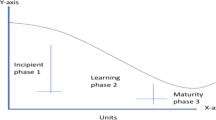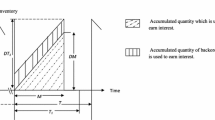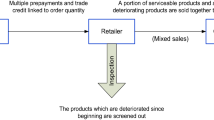Appendix 1
Expressions of \({\mathrm{X}}_{1}, {\mathrm{X}}_{2}, \dots, {\mathrm{X}}_{10}\) which are required for constructing the total profit of Subcase 1.1 are illustrated as follows.
$${\mathrm{X}}_{1}=\frac{1}{(1-\theta )}\left\{\mu (1-\theta )(1-{\mathrm{q}}_{1})+\mathrm{v}\left[\theta (1-{\mathrm{q}}_{2})+(1-\theta){\mathrm{q}}_{1}+\theta {\mathrm{q}}_{2}\right]-\upmu (1-\upgamma )(1-\theta)(1-{\mathrm{q}}_{1})(1-\beta)(1-\alpha)- \mathrm{C}-\mathrm{d}-{\mathrm{C}}_{1}(1-\theta){\mathrm{q}}_{1}- {\mathrm{C}}_{2}\theta {\mathrm{q}}_{2}+\frac{\theta {\mathrm{q}}_{2}{\mathrm{hw}}_{2}}{2}\right\}.$$
(60)
$${\mathrm{X}}_{2}=\frac{1}{\left(1-\theta \right)}\mathrm{S}\left(\left(1-\theta \right){\mathrm{q}}_{1}+\theta \left(1-{\mathrm{q}}_{2}\right)\right).$$
(61)
$${\mathrm{X}}_{3}=\frac{-1}{\left(1-\theta \right)}\left\{{\mathrm{q}}_{1}{\mathrm{w}}_{1}\left(-\mu \left(1-\theta \right)+\mathrm{v}\left(1-\theta \right)+\upmu \left(1-\gamma \right)\left(1-\theta \right)\left(1-\beta \right)\left(1-\alpha \right)-{\mathrm{C}}_{1}\left(1-\theta \right)\right)-{\mathrm{q}}_{2}{\mathrm{w}}_{2}{\mathrm{C}}_{2}\theta \right\}.$$
(62)
$${\mathrm{X}}_{4}=\frac{1}{\left(1-\theta \right)}\left\{{\mathrm{q}}_{1}{\mathrm{w}}_{1}\mathrm{S}(1-\theta )+\mathrm{S}\theta {\mathrm{q}}_{2}{\mathrm{w}}_{2}\right\}.$$
(63)
$${\mathrm{X}}_{5}=\left({\mathrm{CI}}_{\mathrm{P}}(\gamma \left(1-\alpha \right)\mathrm{S}-\alpha \left(\mathrm{N}-\mathrm{S}\right)-\left(1-\alpha \right)\left(1-\gamma \right)\left(\mathrm{N}-\mathrm{S}\right))\right).$$
(64)
$${\mathrm{X}}_{6}=\frac{1}{{\mathrm{x}}_{0}{\left(\left(1-\theta \right)\right)}^{2}}\left[\left(1-\theta \right){\mathrm{q}}_{1}{\mathrm{w}}_{1}-\theta {\mathrm{q}}_{2}{\mathrm{w}}_{2}\right].$$
(65)
$${\mathrm{X}}_{7}=\frac{1}{{\mathrm{x}}_{0}{\left(\left(1-\theta \right)\right)}^{2}}\left[\left(1-\theta \right){\mathrm{q}}_{1}+\theta -\theta {\mathrm{q}}_{2}\right].$$
(66)
$${\mathrm{X}}_{8}=\left(\frac{\mathrm{h}}{2}+\frac{{\mathrm{CI}}_{\mathrm{P}}\left(1-\alpha \right)\left(1-\gamma \right)}{2}+\frac{{\mathrm{CI}}_{\mathrm{P}}\alpha }{2}+\frac{{\mathrm{CI}}_{\mathrm{P}}\gamma \left(1-\alpha \right)}{2}\right).$$
(67)
$${\mathrm{X}}_{9}=\left(\frac{\theta {\mathrm{q}}_{2}\mathrm{h}}{2\left(1-\theta \right)}\right).$$
(68)
$${\mathrm{X}}_{10}=-\frac{1}{2}(\mu {\mathrm{I}}_{\mathrm{e}}(\gamma \left(1-\alpha \right){\mathrm{S}}^{2}+\alpha {\left(\mathrm{S}-\mathrm{N}\right)}^{2}+\left(1-\alpha \right)\left(1-\gamma \right)\beta {\left(\mathrm{S}-\mathrm{N}\right)}^{2})-{\mathrm{CI}}_{\mathrm{P}}\left(\gamma \left(1-\alpha \right){\mathrm{S}}^{2}+\left(1-\alpha \right)\left(1-\gamma \right){\left(\mathrm{N}-\mathrm{S}\right)}^{2}+\alpha {\left(\mathrm{N}-\mathrm{S}\right)}^{2}\right).$$
(69)
Expressions of \({\mathrm{X}}_{11}, {\mathrm{X}}_{12},\) and \({\mathrm{X}}_{13}\) which are required for constructing the total profit of Subcase 1.2 are illustrated as follows.
$${\mathrm{X}}_{11}=\mu {\mathrm{I}}_{\mathrm{e}}\gamma \left(1-\alpha \right)\mathrm{S}-{\mathrm{CI}}_{\mathrm{P}}\alpha \left(\mathrm{N}-\mathrm{S}\right)-{\mathrm{CI}}_{\mathrm{P}}\left(1-\alpha \right)\left(1-\gamma \right)\left(\mathrm{N}-\mathrm{S}\right).$$
(70)
$${\mathrm{X}}_{12}=\left(\frac{\mathrm{h}}{2}+\frac{\mu {\mathrm{I}}_{\mathrm{e}}\gamma \left(1-\alpha \right)}{2}+\frac{{\mathrm{CI}}_{\mathrm{P}}\left(1-\alpha \right)\left(1-\gamma \right)}{2}+\frac{{\mathrm{CI}}_{\mathrm{P}}\alpha }{2}\right).$$
(71)
$${\mathrm{X}}_{13}=-\frac{1}{2}\left(\mu {\mathrm{I}}_{\mathrm{e}}\left(\alpha {\left(\mathrm{S}-\mathrm{N}\right)}^{2}+\left(1-\alpha \right)\left(1-\gamma \right)\beta {\left(\mathrm{S}-\mathrm{N}\right)}^{2}\right)-{\mathrm{CI}}_{\mathrm{P}}\left(\left(1-\alpha \right)\left(1-\gamma \right){\left(\mathrm{N}-\mathrm{S}\right)}^{2}+\alpha {\left(\mathrm{N}-\mathrm{S}\right)}^{2}\right)\right).$$
(72)
Expressions of \({\mathrm{X}}_{14}, {\mathrm{X}}_{15}, \dots, {\mathrm{X}}_{19}\) which are required for constructing the total profit of Subcase 1.3 are illustrated as follows.
$${\mathrm{X}}_{14}=\frac{1}{\left(1-\theta \right)}\left(\mathrm{S}\theta {\mathrm{q}}_{2}+\theta {\mathrm{q}}_{2}{\mathrm{w}}_{2}\right).$$
(73)
$${\mathrm{X}}_{15}=\frac{\mathrm{S}\theta {\mathrm{q}}_{2}{\mathrm{w}}_{2}}{\left(1-\theta \right)}.$$
(74)
$${\mathrm{X}}_{16}=\left(\mu {\mathrm{I}}_{\mathrm{e}}(\alpha \left(\mathrm{S}-\mathrm{N}\right)+\left(1-\alpha \right)\gamma \mathrm{S}+\left(1-\alpha \right)\left(1-\gamma \right)\beta \left(\mathrm{S}-\mathrm{N}\right))\right).$$
(75)
$${\mathrm{X}}_{17}=\frac{{\mathrm{vI}}_{\mathrm{e}}\theta {\mathrm{q}}_{2}}{{\mathrm{x}}_{0}{\left(\left(1-\theta \right)\right)}^{2}}.$$
(76)
$${\mathrm{X}}_{18}=\frac{1}{2}\left(\mathrm{h}+\mu {\mathrm{I}}_{\mathrm{e}}(\alpha +\left(1-\gamma \right)\left(1-\alpha \right)\upbeta +\gamma (1-\alpha ))\right).$$
(77)
$${\mathrm{X}}_{19}=\frac{{\mathrm{vI}}_{\mathrm{e}}\theta {\mathrm{q}}_{2}}{(1-\theta )}.$$
(78)
Expression of \({\mathrm{X}}_{20}\) which is required for constructing the total profit of the Subcase 2.1 is illustrated as follows.
$${\mathrm{X}}_{20}=\left(\frac{{\mathrm{CI}}_{\mathrm{P}}\gamma \left(1-\alpha \right){\mathrm{S}}^{2}}{2}-\frac{\upmu {\mathrm{I}}_{\mathrm{e}}\gamma \left(1-\alpha \right){\mathrm{S}}^{2}}{2}\right).$$
(79)
Appendix 2
To satisfy the necessary conditions of concavity for Subcase 1.1, first and second-order derivatives of \({TP}_{1}\) are calculated. The second-order derivatives concerning variables should be negative.
The first derivative of \({TP}_{1}\) concerning \(e\) is obtained as follows.
$$\frac{\partial {TP}_{1}\left(e,T\right)}{\partial \mathrm{e}}=\frac{4\mathrm{b}{e}^{3}({\mathrm{X}}_{1}+{\mathrm{CI}}_{\mathrm{P}}{\mathrm{X}}_{2})}{\mathrm{F}(T)}+\frac{4\mathrm{b}{e}^{3}({\mathrm{X}}_{3}-{\mathrm{CI}}_{\mathrm{P}}{\mathrm{X}}_{4})}{T(\mathrm{F}(T))}+4\mathrm{b}{e}^{3}{\mathrm{X}}_{5}-\frac{3\mathrm{b}{e}^{2}{\left(\mathrm{a}+\mathrm{b}{e}^{4}\right)}^{2}\mathrm{y}\left(\mathrm{h}+{\mathrm{CI}}_{\mathrm{P}}\right)\left({\mathrm{X}}_{6}-T{\mathrm{X}}_{7}\right)}{T{\left(\mathrm{E}\left(T\right)\right)}^{2}{\left(\mathrm{F}\left(T\right)\right)}^{2}}+\frac{8\mathrm{b}{e}^{3}\left(\mathrm{a}+\mathrm{b}{e}^{4}\right)\left(\mathrm{h}+{\mathrm{CI}}_{\mathrm{P}}\right)\left({\mathrm{X}}_{6}-T{\mathrm{X}}_{7}\right)}{\left(\mathrm{E}\left(T\right)\right){\left(\mathrm{F}\left(T\right)\right)}^{2}}-4\mathrm{b}{e}^{3}T\left({\mathrm{X}}_{8}+\frac{{\mathrm{X}}_{9}}{\mathrm{F}\left(T\right)}\right)-\frac{4{e}^{3}\left(\mathrm{G}+{\mathrm{bX}}_{10}\right)}{T}.$$
(80)
The second derivative of \({TP}_{1}\) concerning \(e\) is obtained as follows.
$$\frac{{\partial }^{2}{TP}_{1}\left(e,T\right)}{\partial {e}^{2}}=\frac{12b{e}^{2}({\mathrm{X}}_{1}+{\mathrm{CI}}_{\mathrm{P}}{\mathrm{X}}_{2})}{\mathrm{F}(T)}+\frac{12\mathrm{b}{e}^{2}({\mathrm{X}}_{3}-{\mathrm{CI}}_{\mathrm{P}}{\mathrm{X}}_{4})}{T\mathrm{F}(T)}+12\mathrm{b}{e}^{2}{\mathrm{X}}_{5}+\frac{18{\mathrm{b}}^{2}{e}^{4}{(\mathrm{a}+\mathrm{b}{e}^{4})}^{2}{\mathrm{y}}^{2}(\mathrm{h}+{\mathrm{CI}}_{\mathrm{P}})({\mathrm{X}}_{6}-T{\mathrm{X}}_{7})}{{T}^{2}{(\mathrm{E}(T))}^{3}{(\mathrm{F}(T))}^{2}}+\frac{\left(\mathrm{h}+{\mathrm{CI}}_{\mathrm{P}}\right)\left({\mathrm{X}}_{6}-T{\mathrm{X}}_{7}\right)}{\mathrm{E}(T)(\mathrm{F}{(T))}^{2}}\left(32{\mathrm{b}}^{2}{e}^{6}+24\mathrm{b}{e}^{2}\left(\mathrm{a}+\mathrm{b}{e}^{4}\right)\right)-\frac{\mathrm{y}\left(\mathrm{h}+{\mathrm{CI}}_{\mathrm{P}}\right)\left({\mathrm{X}}_{6}-T{\mathrm{X}}_{7}\right)}{T{\left(\mathrm{E}\left(T\right)\right)}^{2}(\mathrm{F}{(T))}^{2}}\left(48{\mathrm{b}}^{2}{e}^{5}\left(\mathrm{a}+\mathrm{b}{e}^{4}\right)+6\mathrm{b}e{\left(\mathrm{a}+\mathrm{b}{e}^{4}\right)}^{2}\right)-12\mathrm{b}{e}^{2}T\left({\mathrm{X}}_{8}+\frac{{\mathrm{X}}_{9}}{\mathrm{F}\left(T\right)}\right)-\frac{12{e}^{2}\left(\mathrm{G}+{\mathrm{bX}}_{10}\right)}{T}\le 0.$$
(81)
The first derivative of \({TP}_{1}\) concerning \(T\) is obtained as follows.
$$\frac{\partial {TP}_{1}\left(e,T\right)}{\partial T}=\frac{(\mathrm{a}+\mathrm{b}{e}^{4}){\mathrm{q}}_{1}{\mathrm{w}}_{1}({\mathrm{X}}_{1}+{\mathrm{CI}}_{\mathrm{P}}{\mathrm{X}}_{2})}{{T}^{2}{(\mathrm{F}(T))}^{2}}+\frac{(\mathrm{a}+\mathrm{b}{e}^{4}){\mathrm{q}}_{1}{\mathrm{w}}_{1}({\mathrm{X}}_{3}-{\mathrm{CI}}_{\mathrm{P}}{\mathrm{X}}_{4})}{{T}^{3}{(\mathrm{F}(T))}^{2}}-\frac{\left(\mathrm{a}+\mathrm{b}{e}^{4}\right)\left({\mathrm{X}}_{3}-{\mathrm{CI}}_{\mathrm{P}}{\mathrm{X}}_{4}\right)}{{T}^{2}\left(\mathrm{F}\left(T\right)\right)}-\frac{{\left(\mathrm{a}+\mathrm{b}{e}^{4}\right)}^{2}\left(\mathrm{h}+{\mathrm{CI}}_{\mathrm{P}}\right){\mathrm{X}}_{7}}{\left(\mathrm{E}\left(T\right)\right){\left(\mathrm{F}\left(T\right)\right)}^{2}}+\frac{2{\left(\mathrm{a}+\mathrm{b}{e}^{4}\right)}^{2}\left(\mathrm{h}+{\mathrm{CI}}_{\mathrm{P}}\right){\mathrm{q}}_{1}{\mathrm{w}}_{1}\left({\mathrm{X}}_{6}-T{\mathrm{X}}_{7}\right)}{{T}^{2}\left(\mathrm{E}\left(T\right)\right){\left(\mathrm{F}\left(T\right)\right)}^{3}}+\frac{\mathrm{b}{e}^{3}{\left(\mathrm{a}+\mathrm{b}{e}^{4}\right)}^{2}\mathrm{y}\left(\mathrm{h}+{\mathrm{CI}}_{\mathrm{P}}\right)\left({\mathrm{X}}_{6}-T{\mathrm{X}}_{7}\right)}{{\mathrm{T}}^{2}{\left(\mathrm{E}\left(T\right)\right)}^{2}{\left(\mathrm{F}\left(T\right)\right)}^{2}}-\frac{\left(\mathrm{a}+\mathrm{b}{e}^{4}\right){\mathrm{q}}_{1}{\mathrm{w}}_{1}{\mathrm{X}}_{9}}{T{\left(\mathrm{F}\left(T\right)\right)}^{2}}-\left(\mathrm{a}+\mathrm{b}{e}^{4}\right)\left({\mathrm{X}}_{8}+\frac{{\mathrm{X}}_{9}}{\mathrm{F}\left(T\right)}\right)+\frac{\mathrm{O}+{\mathrm{aX}}_{10}+{e}^{4}\left(\mathrm{G}+{\mathrm{bX}}_{10}\right)}{{T}^{2}}.$$
(82)
The second derivative of \({TP}_{1}\) concerning \(T\) is obtained as follows.
$$\frac{{\partial }^{2}{TP}_{1}\left(e,T\right)}{\partial {T}^{2}}=\frac{2(\mathrm{a}+\mathrm{b}{e}^{4}){\mathrm{q}}_{1}^{2}{\mathrm{w}}_{1}^{2}({\mathrm{X}}_{1}+{\mathrm{CI}}_{\mathrm{P}}{\mathrm{X}}_{2})}{{T}^{4}{(\mathrm{F}(T))}^{3}}-\frac{2\left(\mathrm{a}+\mathrm{b}{e}^{4}\right){\mathrm{q}}_{1}{\mathrm{w}}_{1}\left({\mathrm{X}}_{1}+{\mathrm{CI}}_{\mathrm{P}}{\mathrm{X}}_{2}\right)}{{T}^{3}{\left(\mathrm{F}\left(T\right)\right)}^{2}}+\frac{2\left(\mathrm{a}+\mathrm{b}{e}^{4}\right){\mathrm{q}}_{1}^{2}{\mathrm{w}}_{1}^{2}\left({\mathrm{X}}_{3}-{\mathrm{CI}}_{\mathrm{P}}{\mathrm{X}}_{4}\right)}{{T}^{5}{\left(\mathrm{F}\left(T\right)\right)}^{3}}-\frac{4\left(\mathrm{a}+\mathrm{b}{e}^{4}\right){\mathrm{q}}_{1}{\mathrm{w}}_{1}\left({\mathrm{X}}_{3}-{\mathrm{CI}}_{\mathrm{P}}{\mathrm{X}}_{4}\right)}{{T}^{4}{\left(\mathrm{F}\left(T\right)\right)}^{2}}+\frac{2\left(\mathrm{a}+\mathrm{b}{e}^{4}\right)\left({\mathrm{X}}_{3}-{\mathrm{CI}}_{\mathrm{P}}{\mathrm{X}}_{4}\right)}{{T}^{3}\left(\mathrm{F}\left(T\right)\right)}-\frac{4{\left(\mathrm{a}+\mathrm{b}{e}^{4}\right)}^{2}\left(\mathrm{h}+{\mathrm{CI}}_{\mathrm{P}}\right){\mathrm{q}}_{1}{\mathrm{w}}_{1}{\mathrm{X}}_{7}}{{T}^{2}\left(\mathrm{E}\left(T\right)\right){\left(\mathrm{F}\left(T\right)\right)}^{3}}-\frac{2\mathrm{b}{e}^{3}{\left(\mathrm{a}+\mathrm{b}{e}^{4}\right)}^{2}\mathrm{y}\left(\mathrm{h}+{\mathrm{CI}}_{\mathrm{P}}\right){\mathrm{X}}_{7}}{{T}^{2}{\left(\mathrm{E}\left(T\right)\right)}^{2}{\left(\mathrm{F}\left(T\right)\right)}^{2}}+\frac{6{\left(\mathrm{a}+\mathrm{b}{e}^{4}\right)}^{2}\left(\mathrm{h}+{\mathrm{CI}}_{\mathrm{P}}\right){\mathrm{q}}_{1}^{2}{\mathrm{w}}_{1}^{2}\left({\mathrm{X}}_{6}-T{\mathrm{X}}_{7}\right)}{{T}^{4}\left(\mathrm{E}\left(T\right)\right){\left(\mathrm{F}\left(T\right)\right)}^{4}}+\frac{4\mathrm{b}{e}^{3}{\left(\mathrm{a}+\mathrm{b}{e}^{4}\right)}^{2}\mathrm{y}\left(\mathrm{h}+{\mathrm{CI}}_{\mathrm{P}}\right){\mathrm{q}}_{1}{\mathrm{w}}_{1}\left({\mathrm{X}}_{6}-T{\mathrm{X}}_{7}\right)}{{T}^{4}{\left(\mathrm{E}\left(T\right)\right)}^{2}{\left(\mathrm{F}\left(T\right)\right)}^{3}}-\frac{4{\left(\mathrm{a}+\mathrm{b}{e}^{4}\right)}^{2}\left(\mathrm{h}+{\mathrm{CI}}_{\mathrm{P}}\right){\mathrm{q}}_{1}{\mathrm{w}}_{1}\left({\mathrm{X}}_{6}-T{\mathrm{X}}_{7}\right)}{{T}^{3}\mathrm{E}\left(T\right){\left(\mathrm{F}\left(T\right)\right)}^{3}}+\frac{2{\mathrm{b}}^{2}{e}^{6}{\left(\mathrm{a}+\mathrm{b}{e}^{4}\right)}^{2}{\mathrm{y}}^{2}\left(\mathrm{h}+{\mathrm{CI}}_{\mathrm{P}}\right)\left({\mathrm{X}}_{6}-T{\mathrm{X}}_{7}\right)}{{T}^{4}{\left(\mathrm{E}\left(T\right)\right)}^{3}{\left(\mathrm{F}\left(T\right)\right)}^{2}}-\frac{2\mathrm{b}{e}^{3}{\left(\mathrm{a}+\mathrm{b}{e}^{4}\right)}^{2}\mathrm{y}\left(\mathrm{h}+{\mathrm{CI}}_{\mathrm{P}}\right)\left({\mathrm{X}}_{6}-T{\mathrm{X}}_{7}\right)}{{T}^{3}{\left(\mathrm{E}\left(T\right)\right)}^{2}{\left(\mathrm{F}\left(T\right)\right)}^{2}}-\frac{2\left(\mathrm{a}+\mathrm{b}{e}^{4}\right){\mathrm{q}}_{1}^{2}{\mathrm{w}}_{1}^{2}{\mathrm{X}}_{9}}{{T}^{3}{\left(\mathrm{F}\left(T\right)\right)}^{3}}-\frac{2\left(\mathrm{O}+{\mathrm{aX}}_{10}+{e}^{4}\left(\mathrm{G}+{\mathrm{bX}}_{10}\right)\right)}{{T}^{3}}\le 0.$$
(83)
Due to the complexity of terms in second-order derivatives, the concavity of the total profit function is proved in the section of the numerical experiment.
To satisfy the sufficient condition of concavity for Subcase 1.1, the determinant of the corresponding Hessian matrix must be positive which is formulated as follows.
$$The\, determinant \,of \,H\left({TP}_{1}\left(e,T\right)\right)=\left|\begin{array}{cc}\frac{{\partial }^{2}{TP}_{1}\left(e,T\right)}{{e}^{2}}& \frac{{\partial }^{2}{TP}_{1}\left(e,T\right)}{\partial e\partial T}\\ \frac{{\partial }^{2}{TP}_{1}\left(e,T\right)}{\partial T\partial e}& \frac{{\partial }^{2}{TP}_{1}\left(e,T\right)}{\partial {T}^{2}}\end{array}\right|\ge 0.$$
(84)
Due to the complexity of terms in the Hessian matrix, it is not convenient to prove the positivity of the determinant of the Hessian matrix. Therefore, the positivity of the Hessian matrix is proved in a numerical experiment.
Appendix 3
To satisfy the necessary conditions of concavity for Subcase 1.2, first and second-order derivatives of \({TP}_{2}\) are calculated. The second-order derivatives concerning variables should be negative.
The first derivative of \({TP}_{2}\) concerning \(e\) is obtained as follows.
$$\frac{\partial {TP}_{2}\left(e,T\right)}{\partial e}=\frac{4\mathrm{b}{e}^{3}({\mathrm{X}}_{1}+{\mathrm{vI}}_{\mathrm{e}}{\mathrm{X}}_{2})}{\mathrm{F}(T)}+\frac{4\mathrm{b}{e}^{3}({\mathrm{X}}_{3}-{\mathrm{vI}}_{\mathrm{e}}{\mathrm{X}}_{4})}{T(\mathrm{F}(T))}+4\mathrm{b}{e}^{3}{\mathrm{X}}_{11}-\frac{3\mathrm{b}{e}^{2}{\left(\mathrm{a}+\mathrm{b}{e}^{4}\right)}^{2}\mathrm{y}\left(\mathrm{h}+{\mathrm{vI}}_{\mathrm{e}}\right)\left({\mathrm{X}}_{6}-T{\mathrm{X}}_{7}\right)}{T{\left(\mathrm{E}\left(T\right)\right)}^{2}{\left(\mathrm{F}\left(T\right)\right)}^{2}}+\frac{8\mathrm{b}{e}^{3}\left(\mathrm{a}+\mathrm{b}{e}^{4}\right)\left(\mathrm{h}+{\mathrm{vI}}_{\mathrm{e}}\right)\left({\mathrm{X}}_{6}-T{\mathrm{X}}_{7}\right)}{\left(\mathrm{E}\left(T\right)\right){\left(\mathrm{F}\left(T\right)\right)}^{2}}-4\mathrm{b}{e}^{3}T\left({\mathrm{X}}_{12}+\frac{{\mathrm{X}}_{9}}{\mathrm{F}\left(T\right)}\right)-\frac{4{e}^{3}\left(\mathrm{G}+{\mathrm{bX}}_{13}\right)}{T}.$$
(85)
The second derivative of \({TP}_{2}\) concerning \(e\) is obtained as follows.
$$\frac{{\partial }^{2}{TP}_{2}\left(e,T\right)}{\partial {e}^{2}}=\frac{12\mathrm{b}{e}^{2}({\mathrm{X}}_{1}+{\mathrm{vI}}_{\mathrm{e}}{\mathrm{X}}_{2})}{\mathrm{F}(T)}+\frac{12\mathrm{b}{e}^{2}({\mathrm{X}}_{3}-{\mathrm{vI}}_{\mathrm{e}}{\mathrm{X}}_{4})}{T\mathrm{F}(T)}+12\mathrm{b}{e}^{2}{\mathrm{X}}_{11}+\frac{18{\mathrm{b}}^{2}{e}^{4}{(\mathrm{a}+\mathrm{b}{e}^{4})}^{2}{\mathrm{y}}^{2}(\mathrm{h}+{\mathrm{vI}}_{\mathrm{e}})({\mathrm{X}}_{6}-T{\mathrm{X}}_{7})}{{T}^{2}{(\mathrm{E}(T))}^{3}{(\mathrm{F}(T))}^{2}}+\frac{\left(\mathrm{h}+{\mathrm{vI}}_{\mathrm{e}}\right)\left({\mathrm{X}}_{6}-T{\mathrm{X}}_{7}\right)}{\mathrm{E}(T)(\mathrm{F}{(T))}^{2}}\left(32{\mathrm{b}}^{2}{e}^{6}+24\mathrm{b}{e}^{2}\left(\mathrm{a}+\mathrm{b}{e}^{4}\right)\right)-\frac{\mathrm{y}\left(\mathrm{h}+{\mathrm{vI}}_{\mathrm{e}}\right)\left({\mathrm{X}}_{6}-T{\mathrm{X}}_{7}\right)}{T{\left(\mathrm{E}\left(T\right)\right)}^{2}(\mathrm{F}{(T))}^{2}}\left(48{\mathrm{b}}^{2}{e}^{5}\left(\mathrm{a}+\mathrm{b}{e}^{4}\right)+6\mathrm{b}e{\left(\mathrm{a}+\mathrm{b}{e}^{4}\right)}^{2}\right)-12\mathrm{b}{e}^{2}T\left({\mathrm{X}}_{12 }+\frac{{\mathrm{X}}_{9}}{\mathrm{F}\left(T\right)}\right)-\frac{12{e}^{2}\left(\mathrm{G}+{\mathrm{bX}}_{13}\right)}{T}\le 0.$$
(86)
The first derivative of \({TP}_{2}\) concerning \(T\) is obtained as follows.
$$\frac{\partial {TP}_{2}\left(e,T\right)}{\partial \mathrm{T}}=\frac{(\mathrm{a}+\mathrm{b}{e}^{4}){\mathrm{q}}_{1}{\mathrm{w}}_{1}({\mathrm{X}}_{1}+{\mathrm{vI}}_{\mathrm{e}}{\mathrm{X}}_{2})}{{T}^{2}{(\mathrm{F}(T))}^{2}}+\frac{(\mathrm{a}+\mathrm{b}{e}^{4}){\mathrm{q}}_{1}{\mathrm{w}}_{1}({\mathrm{X}}_{3}-{\mathrm{vI}}_{\mathrm{e}}{\mathrm{X}}_{4})}{{T}^{3}{(\mathrm{F}(T))}^{2}}-\frac{\left(\mathrm{a}+\mathrm{b}{e}^{4}\right)\left({\mathrm{X}}_{3}-{\mathrm{vI}}_{\mathrm{e}}{\mathrm{X}}_{4}\right)}{{T}^{2}\left(\mathrm{F}\left(T\right)\right)}-\frac{{\left(\mathrm{a}+\mathrm{b}{e}^{4}\right)}^{2}\left(\mathrm{h}+{\mathrm{vI}}_{\mathrm{e}}\right){\mathrm{X}}_{7}}{\left(\mathrm{E}\left(T\right)\right){\left(\mathrm{F}\left(T\right)\right)}^{2}}+\frac{2{\left(\mathrm{a}+\mathrm{b}{e}^{4}\right)}^{2}\left(\mathrm{h}+{\mathrm{vI}}_{\mathrm{e}}\right){\mathrm{q}}_{1}{\mathrm{w}}_{1}\left({\mathrm{X}}_{6}-T{\mathrm{X}}_{7}\right)}{{T}^{2}\left(\mathrm{E}\left(T\right)\right){\left(\mathrm{F}\left(T\right)\right)}^{3}}+\frac{\mathrm{b}{e}^{3}{\left(\mathrm{a}+\mathrm{b}{e}^{4}\right)}^{2}\mathrm{y}\left(\mathrm{h}+{\mathrm{vI}}_{\mathrm{e}}\right)\left({\mathrm{X}}_{6}-T{\mathrm{X}}_{7}\right)}{{T}^{2}{\left(\mathrm{E}\left(T\right)\right)}^{2}{\left(\mathrm{F}\left(T\right)\right)}^{2}}-\frac{\left(\mathrm{a}+\mathrm{b}{e}^{4}\right){\mathrm{q}}_{1}{\mathrm{w}}_{1}{\mathrm{X}}_{9}}{T{\left(\mathrm{F}\left(T\right)\right)}^{2}}-\left(\mathrm{a}+\mathrm{b}{e}^{4}\right)\left({\mathrm{X}}_{12}+\frac{{\mathrm{X}}_{9}}{\mathrm{F}\left(T\right)}\right)+\frac{\mathrm{O}+{\mathrm{aX}}_{13}+{e}^{4}\left(\mathrm{G}+{\mathrm{bX}}_{13}\right)}{{T}^{2}}.$$
(87)
The second derivative of \({TP}_{2}\) concerning \(T\) is obtained as follows.
$$\frac{{\partial }^{2}{TP}_{2}\left(e,T\right)}{\partial {T}^{2}}=\frac{2(\mathrm{a}+\mathrm{b}{e}^{4}){\mathrm{q}}_{1}^{2}{\mathrm{w}}_{1}^{2}({\mathrm{X}}_{1}+{\mathrm{vI}}_{\mathrm{e}}{\mathrm{X}}_{2})}{{T}^{4}{(\mathrm{F}(T))}^{3}}-\frac{2\left(\mathrm{a}+\mathrm{b}{e}^{4}\right){\mathrm{q}}_{1}{\mathrm{w}}_{1}\left({\mathrm{X}}_{1}+{\mathrm{vI}}_{\mathrm{e}}{\mathrm{X}}_{2}\right)}{{T}^{3}{\left(F\left(T\right)\right)}^{2}}+\frac{2\left(\mathrm{a}+\mathrm{b}{e}^{4}\right){\mathrm{q}}_{1}^{2}{\mathrm{w}}_{1}^{2}\left({\mathrm{X}}_{3}-{\mathrm{vI}}_{\mathrm{e}}{\mathrm{X}}_{4}\right)}{{T}^{5}{\left(F\left(T\right)\right)}^{3}}-\frac{4\left(\mathrm{a}+\mathrm{b}{e}^{4}\right){\mathrm{q}}_{1}{\mathrm{w}}_{1}\left({\mathrm{X}}_{3}-{\mathrm{vI}}_{\mathrm{e}}{\mathrm{X}}_{4}\right)}{{T}^{4}{\left(F\left(T\right)\right)}^{2}}+\frac{2\left(\mathrm{a}+\mathrm{b}{e}^{4}\right)\left({\mathrm{X}}_{3}-{\mathrm{vI}}_{\mathrm{e}}{\mathrm{X}}_{4}\right)}{{T}^{3}\left(F\left(T\right)\right)}-\frac{4{\left(\mathrm{a}+\mathrm{b}{e}^{4}\right)}^{2}\left(\mathrm{h}+{\mathrm{vI}}_{\mathrm{e}}\right){\mathrm{q}}_{1}{\mathrm{w}}_{1}{\mathrm{X}}_{7}}{{T}^{2}\left(E\left(T\right)\right){\left(F\left(T\right)\right)}^{3}}-\frac{2\mathrm{b}{e}^{3}{\left(\mathrm{a}+\mathrm{b}{e}^{4}\right)}^{2}\mathrm{y}\left(\mathrm{h}+{\mathrm{vI}}_{\mathrm{e}}\right){\mathrm{X}}_{7}}{{T}^{2}{\left(E\left(T\right)\right)}^{2}{\left(F\left(T\right)\right)}^{2}}+\frac{6{\left(\mathrm{a}+\mathrm{b}{e}^{4}\right)}^{2}\left(\mathrm{h}+{\mathrm{vI}}_{\mathrm{e}}\right){\mathrm{q}}_{1}^{2}{\mathrm{w}}_{1}^{2}\left({\mathrm{X}}_{6}-T{\mathrm{X}}_{7}\right)}{{T}^{4}\left(E\left(T\right)\right){\left(F\left(T\right)\right)}^{4}}+\frac{4\mathrm{b}{e}^{3}{\left(\mathrm{a}+\mathrm{b}{e}^{4}\right)}^{2}\mathrm{y}\left(\mathrm{h}+{\mathrm{vI}}_{\mathrm{e}}\right){\mathrm{q}}_{1}{\mathrm{w}}_{1}\left({\mathrm{X}}_{6}-T{\mathrm{X}}_{7}\right)}{{T}^{4}{\left(E\left(T\right)\right)}^{2}{\left(F\left(T\right)\right)}^{3}}-\frac{4{\left(\mathrm{a}+\mathrm{b}{e}^{4}\right)}^{2}\left(\mathrm{h}+{\mathrm{vI}}_{\mathrm{e}}\right){\mathrm{q}}_{1}{\mathrm{w}}_{1}\left({\mathrm{X}}_{6}-T{\mathrm{X}}_{7}\right)}{{T}^{3}E\left(T\right){\left(F\left(T\right)\right)}^{3}}+\frac{2{\mathrm{b}}^{2}{e}^{6}{\left(\mathrm{a}+\mathrm{b}{e}^{4}\right)}^{2}{\mathrm{y}}^{2}\left(\mathrm{h}+{\mathrm{vI}}_{\mathrm{e}}\right)\left({\mathrm{X}}_{6}-T{\mathrm{X}}_{7}\right)}{{T}^{4}{\left(E\left(T\right)\right)}^{3}{\left(F\left(T\right)\right)}^{2}}-\frac{2\mathrm{b}{e}^{3}{\left(\mathrm{a}+\mathrm{b}{e}^{4}\right)}^{2}\mathrm{y}\left(\mathrm{h}+{\mathrm{vI}}_{\mathrm{e}}\right)\left({\mathrm{X}}_{6}-T{\mathrm{X}}_{7}\right)}{{T}^{3}{\left(E\left(T\right)\right)}^{2}{\left(F\left(T\right)\right)}^{2}}-\frac{2\left(\mathrm{a}+\mathrm{b}{e}^{4}\right){\mathrm{q}}_{1}^{2}{\mathrm{w}}_{1}^{2}{\mathrm{X}}_{9}}{{T}^{3}{\left(\mathrm{F}\left(T\right)\right)}^{3}}-\frac{2\left(\mathrm{O}+{\mathrm{aX}}_{13}+{e}^{4}\left(\mathrm{G}+{\mathrm{bX}}_{13}\right)\right)}{{T}^{3}}\le 0.$$
(88)
Due to the complexity of terms in second-order derivatives, the concavity of the total profit function is proved in the section of the numerical experiment.
To satisfy the sufficient condition of concavity for Subcase 1.2, the determinant of the corresponding Hessian matrix must be positive which is formulated as follows.
$${{The \; determinant\; of}} \,H\left({TP}_{2}\left(e,T\right)\right)=\left|\begin{array}{cc}\frac{{\partial }^{2}{TP}_{2}\left(e,T\right)}{{e}^{2}}& \frac{{\partial }^{2}{TP}_{2}\left(e,T\right)}{\partial e\partial T}\\ \frac{{\partial }^{2}{TP}_{2}\left(e,T\right)}{\partial T\partial e}& \frac{{\partial }^{2}{TP}_{2}\left(e,T\right)}{\partial {T}^{2}}\end{array}\right|\ge 0.$$
(89)
Due to the complexity of terms in the Hessian matrix, it is not convenient to prove the positivity of the determinant of the Hessian matrix. Therefore, the positivity of the Hessian matrix is proved in a numerical experiment.
Appendix 4
To satisfy the necessary conditions of concavity for Subcase 1.3, first and second-order derivatives of \({TP}_{3}\) are calculated. The second-order derivatives concerning variables should be negative.
The first derivative of \({TP}_{3}\) concerning \(e\) is obtained as follows.
$$\frac{\partial {TP}_{3}\left(e,T\right)}{\partial e}=-\frac{4{e}^{3}\mathrm{G}}{\mathrm{T}}-\frac{3\mathrm{b}{e}^{2}{\left(\mathrm{a}+\mathrm{b}{e}^{4}\right)}^{2}\mathrm{y}\left(\mathrm{h}+{\mathrm{vI}}_{\mathrm{e}}\right)\left({\mathrm{X}}_{6}-T{\mathrm{X}}_{7}\right)}{\mathrm{T}{\left(\mathrm{E}\left(\mathrm{T}\right)\right)}^{2}{\left(\mathrm{F}\left(\mathrm{T}\right)\right)}^{2}}+\frac{4\mathrm{b}{e}^{3}\left({\mathrm{X}}_{1}+{\mathrm{vI}}_{\mathrm{e}}\left({\mathrm{X}}_{2}+{\mathrm{X}}_{14}\right)\right)}{\mathrm{F}\left(T\right)}+\frac{4\mathrm{b}{e}^{3}\left({\mathrm{X}}_{3}+{\mathrm{vI}}_{\mathrm{e}}\left(-{\mathrm{X}}_{4}+{\mathrm{X}}_{15}\right)\right)}{T\mathrm{F}\left(T\right)}+4\mathrm{b}{e}^{3}{\mathrm{X}}_{16}+8\mathrm{b}{e}^{3}\left(\mathrm{a}+\mathrm{b}{e}^{4}\right)\left(\mathrm{h}+{\mathrm{vI}}_{\mathrm{e}}\right)\left(\frac{{\mathrm{X}}_{6}-T{\mathrm{X}}_{7}}{E\left(T\right){\left(F\left(T\right)\right)}^{2}}-T{\mathrm{X}}_{17}+{\mathrm{W}}_{2}{\mathrm{X}}_{17}\right)-4\mathrm{b}{e}^{3}T\left({\mathrm{X}}_{18}+\frac{{\mathrm{X}}_{9}+{\mathrm{X}}_{19}}{\mathrm{F}\left(T\right)}\right).$$
(90)
The second derivative of \({TP}_{3}\) concerning \(e\) is obtained as follows.
$$\frac{{\partial }^{2}{TP}_{3}\left(e,T\right)}{\partial {e}^{2}}=\frac{18{\mathrm{b}}^{2}{e}^{4}{(\mathrm{a}+\mathrm{b}{e}^{4})}^{2}{\mathrm{y}}^{2}(\mathrm{h}+{\mathrm{vI}}_{\mathrm{e}})({\mathrm{X}}_{6}-T{\mathrm{X}}_{7})}{{T}^{2}{(E(T))}^{3}{(F(T))}^{2}}+\frac{12\mathrm{b}{e}^{2}({\mathrm{X}}_{1}+{\mathrm{vI}}_{\mathrm{e}}({\mathrm{X}}_{2}+{\mathrm{X}}_{14}))}{F(T)}+\frac{12\mathrm{b}{e}^{2}({\mathrm{X}}_{3}+{\mathrm{vI}}_{\mathrm{e}}(-{\mathrm{X}}_{4}+{\mathrm{X}}_{15}))}{TF(T)}+12\mathrm{b}{e}^{2}{\mathrm{X}}_{16}+32{\mathrm{b}}^{2}{e}^{6}\left(\mathrm{h}+{\mathrm{vI}}_{\mathrm{e}}\right)\left(\frac{{\mathrm{X}}_{6}-T{\mathrm{X}}_{7}}{E\left(T\right){\left(F\left(T\right)\right)}^{2}}-T{\mathrm{X}}_{17}+{\mathrm{w}}_{2}{\mathrm{X}}_{17}\right)+24\mathrm{b}{e}^{2}\left(\mathrm{a}+\mathrm{b}{e}^{4}\right)\left(\mathrm{h}+{\mathrm{vI}}_{\mathrm{e}}\right)\left(\frac{{\mathrm{X}}_{6}-{\mathrm{TX}}_{7}}{E\left(T\right){\left(F\left(T\right)\right)}^{2}}-T{\mathrm{X}}_{17}+{\mathrm{w}}_{2}{\mathrm{X}}_{17}\right)-12\mathrm{b}{e}^{2}T\left({\mathrm{X}}_{18}+\frac{{\mathrm{X}}_{9}+{\mathrm{X}}_{19}}{F\left(T\right)}\right)-\frac{12{e}^{2}\mathrm{G}}{T}-\frac{48{\mathrm{b}}^{2}{e}^{5}\left(\mathrm{a}+\mathrm{b}{e}^{4}\right)\mathrm{y}\left(\mathrm{h}+{\mathrm{vI}}_{\mathrm{e}}\right)\left({\mathrm{X}}_{6}-T{\mathrm{X}}_{7}\right)}{T{\left(E\left(T\right)\right)}^{2}{\left(F\left(T\right)\right)}^{2}}-\frac{6\mathrm{b}e{\left(\mathrm{a}+\mathrm{b}{e}^{4}\right)}^{2}\mathrm{y}\left(\mathrm{h}+{\mathrm{vI}}_{\mathrm{e}}\right)\left({\mathrm{X}}_{6}-T{\mathrm{X}}_{7}\right)}{T{\left(E\left(T\right)\right)}^{2}{\left(F\left(T\right)\right)}^{2}}\le 0.$$
(91)
The first derivative of \({TP}_{3}\) concerning \(T\) is obtained as follows.
$$\frac{\partial {TP}_{3}\left(e,T\right)}{\partial T}=\frac{{e}^{4}\mathrm{G}+\mathrm{O}}{{T}^{2}}+\frac{(\mathrm{a}+\mathrm{b}{e}^{4}){\mathrm{q}}_{1}{\mathrm{w}}_{1}({\mathrm{X}}_{1}+{\mathrm{vI}}_{\mathrm{e}}({\mathrm{X}}_{2}+{\mathrm{X}}_{14}))}{{T}^{2}{(F(T))}^{2}}+\frac{(\mathrm{a}+\mathrm{b}{e}^{4}){\mathrm{q}}_{1}{\mathrm{w}}_{1}({\mathrm{X}}_{3}+{\mathrm{vI}}_{\mathrm{e}}(-{\mathrm{X}}_{4}+{\mathrm{X}}_{15}))}{{T}^{3}{(F(T))}^{2}}-\frac{\left(\mathrm{a}+\mathrm{b}{e}^{4}\right)\left({\mathrm{X}}_{3}+{\mathrm{vI}}_{\mathrm{e}}\left(-{\mathrm{X}}_{4}+{\mathrm{X}}_{15}\right)\right)}{{T}^{2}F\left(T\right)}+{\left(\mathrm{a}+\mathrm{b}{e}^{4}\right)}^{2}\left(\mathrm{h}+{\mathrm{vI}}_{\mathrm{e}}\right)\left(-\frac{{\mathrm{X}}_{7}}{E\left(T\right){\left(F\left(T\right)\right)}^{2}}+\frac{2{\mathrm{q}}_{1}{\mathrm{w}}_{1}\left({\mathrm{X}}_{6}-T{\mathrm{X}}_{7}\right)}{{T}^{2}E\left(T\right){\left(F\left(T\right)\right)}^{3}}+\frac{\mathrm{b}{e}^{3}\mathrm{y}\left({\mathrm{X}}_{6}-T{\mathrm{X}}_{7}\right)}{{T}^{2}{\left(E\left(T\right)\right)}^{2}{\left(F\left(T\right)\right)}^{2}}-{\mathrm{X}}_{17}\right)-\frac{\left(\mathrm{a}+\mathrm{b}{e}^{4}\right){\mathrm{q}}_{1}{\mathrm{w}}_{1}\left({\mathrm{X}}_{9}+{\mathrm{X}}_{19}\right)}{T{\left(F\left(T\right)\right)}^{2}}-\left(\mathrm{a}+\mathrm{b}{e}^{4}\right)\left({\mathrm{X}}_{18}+\frac{{\mathrm{X}}_{9}+{\mathrm{X}}_{19}}{F\left(T\right)}\right).$$
(92)
The second derivative of \({TP}_{3}\) concerning \(T\) is obtained as follows.
$$\frac{{\partial }^{2}{TP}_{3}\left(e,T\right)}{\partial {T}^{2}}=-\frac{2\left({e}^{4}\mathrm{G}+\mathrm{O}\right)}{{T}^{3}}+{\left(\mathrm{a}+\mathrm{b}{e}^{4}\right)}^{2}\left(\mathrm{h}+{\mathrm{vI}}_{\mathrm{e}}\right)\left(-\frac{4{\mathrm{q}}_{1}{\mathrm{w}}_{1}{\mathrm{X}}_{7}}{{T}^{2}E\left(T\right){\left(F\left(T\right)\right)}^{3}}-\frac{2\mathrm{b}{e}^{3}{\mathrm{yX}}_{7}}{{T}^{2}{\left(E\left(T\right)\right)}^{2}{\left(F\left(T\right)\right)}^{2}}+\frac{6{\mathrm{q}}_{1}^{2}{\mathrm{w}}_{1}^{2}\left({\mathrm{X}}_{6}-T{\mathrm{X}}_{7}\right)}{{T}^{4}E\left(T\right){\left(F\left(T\right)\right)}^{4}}+\frac{4\mathrm{b}{e}^{3}{\mathrm{yq}}_{1}{\mathrm{w}}_{1}\left({\mathrm{X}}_{6}-T{\mathrm{X}}_{7}\right)}{{T}^{4}{\left(E\left(T\right)\right)}^{2}{\left(F\left(T\right)\right)}^{3}}-\frac{4{\mathrm{q}}_{1}{\mathrm{w}}_{1}\left({\mathrm{X}}_{6}-T{\mathrm{X}}_{7}\right)}{{T}^{3}E\left(T\right){\left(F\left(T\right)\right)}^{3}}+\frac{2{\mathrm{b}}^{2}{e}^{6}{\mathrm{y}}^{2}\left({\mathrm{X}}_{6}-T{\mathrm{X}}_{7}\right)}{{T}^{4}{\left(E\left(T\right)\right)}^{3}{\left(F\left(T\right)\right)}^{2}}-\frac{2\mathrm{b}{e}^{3}\mathrm{y}\left({\mathrm{X}}_{6}-T{\mathrm{X}}_{7}\right)}{{T}^{3}{\left(E\left(T\right)\right)}^{2}{\left(F\left(T\right)\right)}^{2}}\right)+\frac{2\left(\mathrm{a}+{\mathrm{be}}^{4}\right){\mathrm{q}}_{1}^{2}{\mathrm{w}}_{1}^{2}\left({\mathrm{X}}_{1}+{\mathrm{vI}}_{\mathrm{e}}\left({\mathrm{X}}_{2}+{\mathrm{X}}_{14}\right)\right)}{{\mathrm{T}}^{4}{\left(\mathrm{F}\left(\mathrm{T}\right)\right)}^{3}}-\frac{2\left(\mathrm{a}+{\mathrm{be}}^{4}\right){\mathrm{q}}_{1}{\mathrm{w}}_{1}\left({\mathrm{X}}_{1}+{\mathrm{vI}}_{\mathrm{e}}\left({\mathrm{X}}_{2}+{\mathrm{X}}_{14}\right)\right)}{{T}^{3}{\left(F\left(T\right)\right)}^{2}}+\frac{2\left(\mathrm{a}+{\mathrm{be}}^{4}\right){\mathrm{q}}_{1}^{2}{\mathrm{w}}_{1}^{2}\left({\mathrm{X}}_{3}+{\mathrm{vI}}_{\mathrm{e}}\left(-{\mathrm{X}}_{4}+{\mathrm{X}}_{15}\right)\right)}{{T}^{5}{\left(F\left(T\right)\right)}^{3}}-\frac{4\left(\mathrm{a}+\mathrm{b}{e}^{4}\right){\mathrm{q}}_{1}{\mathrm{w}}_{1}\left({\mathrm{X}}_{3}+{\mathrm{vI}}_{\mathrm{e}}\left(-{\mathrm{X}}_{4}+{\mathrm{X}}_{15}\right)\right)}{{T}^{4}{\left(F\left(T\right)\right)}^{2}}+\frac{2\left(\mathrm{a}+\mathrm{b}{e}^{4}\right)\left({\mathrm{X}}_{3}+{\mathrm{vI}}_{\mathrm{e}}\left(-{\mathrm{X}}_{4}+{\mathrm{X}}_{15}\right)\right)}{{T}^{3}F\left(T\right)}-\frac{2\left(\mathrm{a}+\mathrm{b}{e}^{4}\right){\mathrm{q}}_{1}^{2}{\mathrm{w}}_{1}^{2}\left({\mathrm{X}}_{9}+{\mathrm{X}}_{19}\right)}{{T}^{3}{\left(F\left(T\right)\right)}^{3}}\le 0.$$
(93)
Due to the complexity of terms in second-order derivatives, the concavity of the total profit function is proved in the section of the numerical experiment.
To satisfy the sufficient condition of concavity for Subcase 1.3, the determinant of the corresponding Hessian matrix must be positive which is formulated as follows.
$${{The \;determinant \;of}}\, H\left({TP}_{3}\left(e,T\right)\right)=\left|\begin{array}{cc}\frac{{\partial }^{2}{TP}_{3}\left(e,T\right)}{{e}^{2}}& \frac{{\partial }^{2}{TP}_{3}\left(e,T\right)}{\partial e\partial T}\\ \frac{{\partial }^{2}{TP}_{3}\left(e,T\right)}{\partial T\partial e}& \frac{{\partial }^{2}{TP}_{3}\left(e,T\right)}{\partial {T}^{2}}\end{array}\right|\ge 0.$$
(94)
Due to the complexity of terms in the Hessian matrix, it is not convenient to prove the positivity of the determinant of the Hessian matrix. Therefore, the positivity of the Hessian matrix is proved in a numerical experiment.
Appendix 5
To satisfy the necessary conditions of concavity for Subcase 2.1, first and second-order derivatives of \({TP}_{4}\) are calculated. The second-order derivatives concerning variables should be negative.
The first derivative of \({TP}_{4}\) concerning \(e\) is obtained as follows.
$$\frac{\partial {TP}_{4}\left(e,T\right)}{\partial \mathrm{e}}=\frac{4\mathrm{b}{e}^{3}({\mathrm{X}}_{1}+{\mathrm{CI}}_{\mathrm{P}}{\mathrm{X}}_{2})}{F(T)}+\frac{4\mathrm{b}{e}^{3}({\mathrm{X}}_{3}-{\mathrm{CI}}_{\mathrm{P}}{\mathrm{X}}_{4})}{T(F(T))}+4\mathrm{b}{e}^{3}{\mathrm{X}}_{5}-\frac{3\mathrm{b}{e}^{2}{\left(\mathrm{a}+\mathrm{b}{e}^{4}\right)}^{2}\mathrm{y}\left(\mathrm{h}+{\mathrm{CI}}_{\mathrm{P}}\right)\left({\mathrm{X}}_{6}-T{\mathrm{X}}_{7}\right)}{T{\left(E\left(T\right)\right)}^{2}{\left(F\left(T\right)\right)}^{2}}+\frac{8\mathrm{b}{e}^{3}\left(\mathrm{a}+\mathrm{b}{e}^{4}\right)\left(\mathrm{h}+{\mathrm{CI}}_{\mathrm{P}}\right)\left({\mathrm{X}}_{6}-T{\mathrm{X}}_{7}\right)}{\left(E\left(T\right)\right){\left(F\left(T\right)\right)}^{2}}-4\mathrm{b}{e}^{3}\mathrm{T}\left({\mathrm{X}}_{8}+\frac{{\mathrm{X}}_{9}}{F\left(T\right)}\right)-\frac{4{e}^{3}\left(\mathrm{G}+{\mathrm{bX}}_{20}\right)}{T}.$$
(95)
The second derivative of \({TP}_{4}\) concerning \(e\) is obtained as follows.
$$\frac{{\partial }^{2}{TP}_{4}\left(e,T\right)}{\partial {e}^{2}}=\frac{12\mathrm{b}{e}^{2}({\mathrm{X}}_{1}+{\mathrm{CI}}_{\mathrm{P}}{\mathrm{X}}_{2})}{F(T)}+\frac{12\mathrm{b}{e}^{2}({\mathrm{X}}_{3}-{\mathrm{CI}}_{\mathrm{P}}{\mathrm{X}}_{4})}{TF(T)}+12\mathrm{b}{e}^{2}{\mathrm{X}}_{5}+\frac{18{\mathrm{b}}^{2}{e}^{4}{(\mathrm{a}+\mathrm{b}{e}^{4})}^{2}{\mathrm{y}}^{2}(\mathrm{h}+{\mathrm{CI}}_{\mathrm{P}})({\mathrm{X}}_{6}-T{\mathrm{X}}_{7})}{{T}^{2}{(E(T))}^{3}{(F(T))}^{2}}+\frac{\left(\mathrm{h}+{\mathrm{CI}}_{\mathrm{P}}\right)\left({\mathrm{X}}_{6}-T{\mathrm{X}}_{7}\right)}{E(T)(F{(T))}^{2}}\left(32{\mathrm{b}}^{2}{e}^{6}+24\mathrm{b}{e}^{2}\left(\mathrm{a}+\mathrm{b}{e}^{4}\right)\right)-\frac{\mathrm{y}\left(\mathrm{h}+{\mathrm{CI}}_{\mathrm{P}}\right)\left({\mathrm{X}}_{6}-T{\mathrm{X}}_{7}\right)}{T{\left(E\left(T\right)\right)}^{2}(F{(T))}^{2}}\left(48{\mathrm{b}}^{2}{e}^{5}\left(\mathrm{a}+\mathrm{b}{e}^{4}\right)+6\mathrm{b}e{\left(\mathrm{a}+\mathrm{b}{e}^{4}\right)}^{2}\right)-12\mathrm{b}{e}^{2}T\left({\mathrm{X}}_{8}+\frac{{\mathrm{X}}_{9}}{F\left(T\right)}\right)-\frac{12{e}^{2}\left(\mathrm{G}+{\mathrm{bX}}_{20}\right)}{T}\le 0.$$
(96)
The first derivative of \({TP}_{4}\) concerning \(T\) is obtained as follows.
$$\frac{\partial {TP}_{4}\left(e,T\right)}{\partial T}=\frac{(\mathrm{a}+\mathrm{b}{e}^{4}){\mathrm{q}}_{1}{\mathrm{w}}_{1}({\mathrm{X}}_{1}+{\mathrm{CI}}_{\mathrm{P}}{\mathrm{X}}_{2})}{{T}^{2}{(\mathrm{F}(T))}^{2}}+\frac{(\mathrm{a}+\mathrm{b}{e}^{4}){\mathrm{q}}_{1}{\mathrm{w}}_{1}({\mathrm{X}}_{3}-{\mathrm{CI}}_{\mathrm{P}}{\mathrm{X}}_{4})}{{T}^{3}{(F(T))}^{2}}-\frac{\left(\mathrm{a}+\mathrm{b}{e}^{4}\right)\left({\mathrm{X}}_{3}-{\mathrm{CI}}_{\mathrm{P}}{\mathrm{X}}_{4}\right)}{{T}^{2}\left(F\left(T\right)\right)}-\frac{{\left(\mathrm{a}+\mathrm{b}{e}^{4}\right)}^{2}\left(\mathrm{h}+{\mathrm{CI}}_{\mathrm{P}}\right){\mathrm{X}}_{7}}{\left(E\left(T\right)\right){\left(F\left(T\right)\right)}^{2}}+\frac{2{\left(\mathrm{a}+\mathrm{b}{e}^{4}\right)}^{2}\left(\mathrm{h}+{\mathrm{CI}}_{\mathrm{P}}\right){\mathrm{q}}_{1}{\mathrm{w}}_{1}\left({\mathrm{X}}_{6}-T{\mathrm{X}}_{7}\right)}{{T}^{2}\left(E\left(T\right)\right){\left(F\left(T\right)\right)}^{3}}+\frac{{\mathrm{be}}^{3}{\left(\mathrm{a}+\mathrm{b}{e}^{4}\right)}^{2}\mathrm{y}\left(\mathrm{h}+{\mathrm{CI}}_{\mathrm{P}}\right)\left({\mathrm{X}}_{6}-T{\mathrm{X}}_{7}\right)}{{T}^{2}{\left(E\left(T\right)\right)}^{2}{\left(F\left(T\right)\right)}^{2}}-\frac{\left(\mathrm{a}+\mathrm{b}{e}^{4}\right){\mathrm{q}}_{1}{\mathrm{w}}_{1}{\mathrm{X}}_{9}}{T{\left(F\left(T\right)\right)}^{2}}-\left(\mathrm{a}+\mathrm{b}{e}^{4}\right)\left({\mathrm{X}}_{8}+\frac{{\mathrm{X}}_{9}}{F\left(T\right)}\right)+\frac{\mathrm{O}+{\mathrm{aX}}_{20}+{e}^{4}\left(\mathrm{G}+{\mathrm{bX}}_{20}\right)}{{T}^{2}}.$$
(97)
The second derivative of \({TP}_{4}\) concerning \(T\) is obtained as follows.
$$\frac{{\partial }^{2}{TP}_{4}\left(e,T\right)}{\partial {T}^{2}}=\frac{2(\mathrm{a}+\mathrm{b}{e}^{4}){\mathrm{q}}_{1}^{2}{\mathrm{w}}_{1}^{2}({\mathrm{X}}_{1}+{\mathrm{CI}}_{\mathrm{P}}{\mathrm{X}}_{2})}{{T}^{4}{(F(T))}^{3}}-\frac{2\left(\mathrm{a}+\mathrm{b}{e}^{4}\right){\mathrm{q}}_{1}{\mathrm{w}}_{1}\left({\mathrm{X}}_{1}+{\mathrm{CI}}_{\mathrm{P}}{\mathrm{X}}_{2}\right)}{{T}^{3}{\left(F\left(T\right)\right)}^{2}}+\frac{2\left(\mathrm{a}+\mathrm{b}{e}^{4}\right){\mathrm{q}}_{1}^{2}{\mathrm{w}}_{1}^{2}\left({\mathrm{X}}_{3}-{\mathrm{CI}}_{\mathrm{P}}{\mathrm{X}}_{4}\right)}{{T}^{5}{\left(F\left(T\right)\right)}^{3}}-\frac{4\left(\mathrm{a}+\mathrm{b}{e}^{4}\right){\mathrm{q}}_{1}{\mathrm{w}}_{1}\left({\mathrm{X}}_{3}-{\mathrm{CI}}_{\mathrm{P}}{\mathrm{X}}_{4}\right)}{{T}^{4}{\left(F\left(T\right)\right)}^{2}}+\frac{2\left(\mathrm{a}+\mathrm{b}{e}^{4}\right)\left({\mathrm{X}}_{3}-{\mathrm{CI}}_{\mathrm{P}}{\mathrm{X}}_{4}\right)}{{T}^{3}\left(F\left(T\right)\right)}-\frac{4{\left(\mathrm{a}+\mathrm{b}{e}^{4}\right)}^{2}\left(\mathrm{h}+{\mathrm{CI}}_{\mathrm{P}}\right){\mathrm{q}}_{1}{\mathrm{w}}_{1}{\mathrm{X}}_{7}}{{T}^{2}\left(E\left(T\right)\right){\left(F\left(T\right)\right)}^{3}}-\frac{2\mathrm{b}{e}^{3}{\left(\mathrm{a}+\mathrm{b}{e}^{4}\right)}^{2}\mathrm{y}\left(\mathrm{h}+{\mathrm{CI}}_{\mathrm{P}}\right){\mathrm{X}}_{7}}{{T}^{2}{\left(E\left(T\right)\right)}^{2}{\left(F\left(T\right)\right)}^{2}}+\frac{6{\left(\mathrm{a}+\mathrm{b}{e}^{4}\right)}^{2}\left(\mathrm{h}+{\mathrm{CI}}_{\mathrm{P}}\right){\mathrm{q}}_{1}^{2}{\mathrm{w}}_{1}^{2}\left({\mathrm{X}}_{6}-T{\mathrm{X}}_{7}\right)}{{T}^{4}\left(E\left(T\right)\right){\left(F\left(T\right)\right)}^{4}}+\frac{4\mathrm{b}{e}^{3}{\left(\mathrm{a}+\mathrm{b}{e}^{4}\right)}^{2}\mathrm{y}\left(\mathrm{h}+{\mathrm{CI}}_{\mathrm{P}}\right){\mathrm{q}}_{1}{\mathrm{w}}_{1}\left({\mathrm{X}}_{6}-T{\mathrm{X}}_{7}\right)}{{T}^{4}{\left(E\left(T\right)\right)}^{2}{\left(F\left(T\right)\right)}^{3}}-\frac{4{\left(\mathrm{a}+\mathrm{b}{e}^{4}\right)}^{2}\left(\mathrm{h}+{\mathrm{CI}}_{\mathrm{P}}\right){\mathrm{q}}_{1}{\mathrm{w}}_{1}\left({\mathrm{X}}_{6}-T{\mathrm{X}}_{7}\right)}{{T}^{3}E\left(T\right){\left(F\left(T\right)\right)}^{3}}+\frac{2{\mathrm{b}}^{2}{e}^{6}{\left(\mathrm{a}+\mathrm{b}{e}^{4}\right)}^{2}{\mathrm{y}}^{2}\left(\mathrm{h}+{\mathrm{CI}}_{\mathrm{P}}\right)\left({\mathrm{X}}_{6}-T{\mathrm{X}}_{7}\right)}{{T}^{4}{\left(E\left(T\right)\right)}^{3}{\left(F\left(T\right)\right)}^{2}}-\frac{2\mathrm{b}{e}^{3}{\left(\mathrm{a}+\mathrm{b}{e}^{4}\right)}^{2}\mathrm{y}\left(\mathrm{h}+{\mathrm{CI}}_{\mathrm{P}}\right)\left({\mathrm{X}}_{6}-T{\mathrm{X}}_{7}\right)}{{T}^{3}{\left(E\left(T\right)\right)}^{2}{\left(F\left(T\right)\right)}^{2}}-\frac{2\left(\mathrm{a}+\mathrm{b}{e}^{4}\right){\mathrm{q}}_{1}^{2}{\mathrm{w}}_{1}^{2}{\mathrm{X}}_{9}}{{T}^{3}{\left(F\left(T\right)\right)}^{3}}-\frac{2\left(\mathrm{O}+{\mathrm{aX}}_{20}+{e}^{4}\left(\mathrm{G}+{\mathrm{bX}}_{20}\right)\right)}{{T}^{3}}\le 0.$$
(98)
Due to the complexity of terms in second-order derivatives, the concavity of the total profit function is proved in the section of the numerical experiment.
To satisfy the sufficient condition of concavity for Subcase 2.1, the determinant of the corresponding Hessian matrix must be positive which is formulated as follows.
$${ {The \; determinant \;of}} H\left({TP}_{4}\left(e,T\right)\right)=\left|\begin{array}{cc}\frac{{\partial }^{2}{TP}_{4}\left(e,T\right)}{{e}^{2}}& \frac{{\partial }^{2}{TP}_{4}\left(e,T\right)}{\partial e\partial T}\\ \frac{{\partial }^{2}{TP}_{4}\left(e,T\right)}{\partial T\partial e}& \frac{{\partial }^{2}{TP}_{4}\left(e,T\right)}{\partial {T}^{2}}\end{array}\right|\ge 0.$$
(99)
Due to the complexity of terms in the Hessian matrix, it is not convenient to prove the positivity of the determinant of the Hessian matrix. Therefore, the positivity of the Hessian matrix is proved in a numerical experiment.
Appendix 6
To satisfy the necessary conditions of concavity for Subcase 2.2, first and second-order derivatives of \({TP}_{5}\) are calculated. The second-order derivatives concerning variables should be negative.
The first derivative of \({TP}_{5}\) concerning \(e\) is obtained as follows.
$$\frac{\partial {TP}_{5}\left(e,T\right)}{\partial e}=-\frac{4{e}^{3}\mathrm{G}}{T}+\frac{4\mathrm{b}{e}^{3}\left({\mathrm{X}}_{1}+{\mathrm{vI}}_{\mathrm{e}}{\mathrm{X}}_{2}\right)}{F\left(T\right)}+\frac{4\mathrm{b}{e}^{3}\left({\mathrm{X}}_{3}-{\mathrm{vI}}_{\mathrm{e}}{\mathrm{X}}_{4}\right)}{TF\left(T\right)}-\frac{3\mathrm{b}{e}^{2}{\left(\mathrm{a}+\mathrm{b}{e}^{4}\right)}^{2}\mathrm{y}\left(\mathrm{h}+{\mathrm{vI}}_{\mathrm{e}}\right)\left({\mathrm{X}}_{6}-T{\mathrm{X}}_{7}\right)}{T{\left(E\left(T\right)\right)}^{2}{\left(F\left(T\right)\right)}^{2}}+\frac{8\mathrm{b}{e}^{3}\left(\mathrm{a}+\mathrm{b}{e}^{4}\right)\left(\mathrm{h}+{\mathrm{vI}}_{\mathrm{e}}\right)\left({\mathrm{X}}_{6}-T{\mathrm{X}}_{7}\right)}{E\left(T\right){\left(F\left(T\right)\right)}^{2}}+4\mathrm{b}{e}^{3}{\mathrm{X}}_{11}-4\mathrm{b}{e}^{3}\mathrm{T}\left(\frac{{\mathrm{X}}_{9}}{F\left(T\right)}+{\mathrm{X}}_{12}\right).$$
(100)
The second derivative of \({TP}_{5}\) concerning \(e\) is obtained as follows.
$$\frac{{\partial }^{2}{TP}_{5}\left(e,T\right)}{\partial {e}^{2}}=-\frac{12{e}^{2}\mathrm{G}}{T}+\frac{12\mathrm{b}{e}^{2}\left({\mathrm{X}}_{1}+{\mathrm{vI}}_{\mathrm{e}}{\mathrm{X}}_{2}\right)}{F\left(T\right)}+\frac{12\mathrm{b}{e}^{2}\left({\mathrm{X}}_{3}-{\mathrm{vI}}_{\mathrm{e}}{\mathrm{X}}_{4}\right)}{TF\left(T\right)}+\frac{18{\mathrm{b}}^{2}{e}^{4}{\left(\mathrm{a}+\mathrm{b}{e}^{4}\right)}^{2}{\mathrm{y}}^{2}\left(\mathrm{h}+{\mathrm{vI}}_{\mathrm{e}}\right)\left({\mathrm{X}}_{6}-T{\mathrm{X}}_{7}\right)}{{T}^{2}{\left(E\left(T\right)\right)}^{3}{\left(F\left(T\right)\right)}^{2}}-\frac{48{\mathrm{b}}^{2}{e}^{5}\left(\mathrm{a}+\mathrm{b}{e}^{4}\right)\mathrm{y}\left(\mathrm{h}+{\mathrm{vI}}_{\mathrm{e}}\right)\left({\mathrm{X}}_{6}-T{\mathrm{X}}_{7}\right)}{T{\left(E\left(T\right)\right)}^{2}{\left(F\left(T\right)\right)}^{2}}-\frac{6\mathrm{b}e{\left(\mathrm{a}+\mathrm{b}{e}^{4}\right)}^{2}\mathrm{y}\left(\mathrm{h}+{\mathrm{vI}}_{\mathrm{e}}\right)\left({\mathrm{X}}_{6}-T{\mathrm{X}}_{7}\right)}{T{\left(E\left(T\right)\right)}^{2}{\left(F\left(T\right)\right)}^{2}}+\frac{32{\mathrm{b}}^{2}{e}^{6}\left(\mathrm{h}+{\mathrm{vI}}_{\mathrm{e}}\right)\left({\mathrm{X}}_{6}-T{\mathrm{X}}_{7}\right)}{E\left(T\right){\left(F\left(T\right)\right)}^{2}}+\frac{24\mathrm{b}{e}^{2}\left(\mathrm{a}+\mathrm{b}{e}^{4}\right)\left(\mathrm{h}+{\mathrm{vI}}_{\mathrm{e}}\right)\left({\mathrm{X}}_{6}-T{\mathrm{X}}_{7}\right)}{E\left(T\right){\left(F\left(T\right)\right)}^{2}}+12\mathrm{b}{e}^{2}{\mathrm{X}}_{11}-12\mathrm{b}{e}^{2}\mathrm{T}\left(\frac{{\mathrm{X}}_{9}}{F\left(T\right)}+{\mathrm{X}}_{12}\right)\le 0.$$
(101)
The first derivative of \({TP}_{5}\) concerning \(T\) is obtained as follows.
$$\frac{\partial {TP}_{5}\left(e,T\right)}{\partial T}=\frac{{e}^{4}\mathrm{G}+\mathrm{O}}{{T}^{2}}+\frac{(\mathrm{a}+\mathrm{b}{e}^{4}){\mathrm{q}}_{1}{\mathrm{w}}_{1}({\mathrm{X}}_{1}+{\mathrm{vI}}_{\mathrm{e}}{\mathrm{X}}_{2})}{{T}^{2}{(F(T))}^{2}}+\frac{(\mathrm{a}+\mathrm{b}{e}^{4}){\mathrm{q}}_{1}{\mathrm{w}}_{1}({\mathrm{X}}_{3}-{\mathrm{vI}}_{\mathrm{e}}{\mathrm{X}}_{4})}{{T}^{3}{(F(T))}^{2}}-\frac{\left(\mathrm{a}+\mathrm{b}{e}^{4}\right)\left({\mathrm{X}}_{3}-{\mathrm{vI}}_{\mathrm{e}}{\mathrm{X}}_{4}\right)}{{T}^{2}F\left(T\right)}-\frac{{\left(\mathrm{a}+\mathrm{b}{e}^{4}\right)}^{2}\left(\mathrm{h}+{\mathrm{vI}}_{\mathrm{e}}\right){\mathrm{X}}_{7}}{E\left(T\right){\left(F\left(T\right)\right)}^{2}}+\frac{2{\left(\mathrm{a}+\mathrm{b}{e}^{4}\right)}^{2}\left(\mathrm{h}+{\mathrm{vI}}_{\mathrm{e}}\right){\mathrm{q}}_{1}{\mathrm{w}}_{1}\left({\mathrm{X}}_{6}-T{\mathrm{X}}_{7}\right)}{{T}^{2}E\left(T\right){\left(F\left(T\right)\right)}^{3}}+\frac{\mathrm{b}{e}^{3}{\left(\mathrm{a}+\mathrm{b}{e}^{4}\right)}^{2}\mathrm{y}\left(\mathrm{h}+{\mathrm{vI}}_{\mathrm{e}}\right)\left({\mathrm{X}}_{6}-T{\mathrm{X}}_{7}\right)}{{T}^{2}{\left(E\left(T\right)\right)}^{2}{\left(F\left(T\right)\right)}^{2}}-\frac{\left(\mathrm{a}+\mathrm{b}{e}^{4}\right){\mathrm{q}}_{1}{\mathrm{w}}_{1}{\mathrm{X}}_{9}}{T{\left(F\left(T\right)\right)}^{2}}-\left(\mathrm{a}+\mathrm{b}{e}^{4}\right)\left(\frac{{\mathrm{X}}_{9}}{\mathrm{F}\left(\mathrm{T}\right)}+{\mathrm{X}}_{12}\right).$$
(102)
The second derivative of \({TP}_{5}\) concerning \(T\) is obtained as follows.
$$\frac{{\partial }^{2}{TP}_{5}\left(e,T\right)}{\partial {T}^{2}}=-\frac{2\left({e}^{4}\mathrm{G}+\mathrm{O}\right)}{{T}^{3}}+\frac{2\left(\mathrm{a}+\mathrm{b}{e}^{4}\right){\mathrm{q}}_{1}^{2}{\mathrm{w}}_{1}^{2}\left({\mathrm{X}}_{1}+{\mathrm{vI}}_{\mathrm{e}}{\mathrm{X}}_{2}\right)}{{T}^{4}{\left(F\left(T\right)\right)}^{3}}-\frac{2\left(\mathrm{a}+\mathrm{b}{e}^{4}\right){\mathrm{q}}_{1}{\mathrm{w}}_{1}\left({\mathrm{X}}_{1}+{\mathrm{vI}}_{\mathrm{e}}{\mathrm{X}}_{2}\right)}{{T}^{3}{\left(F\left(T\right)\right)}^{2}}+\frac{2\left(\mathrm{a}+\mathrm{b}{e}^{4}\right){\mathrm{q}}_{1}^{2}{\mathrm{w}}_{1}^{2}\left({\mathrm{X}}_{3}-{\mathrm{vI}}_{\mathrm{e}}{\mathrm{X}}_{4}\right)}{{T}^{5}{\left(F\left(T\right)\right)}^{3}}-\frac{4\left(\mathrm{a}+\mathrm{b}{e}^{4}\right){\mathrm{q}}_{1}{\mathrm{w}}_{1}\left({\mathrm{X}}_{3}-{\mathrm{vI}}_{\mathrm{e}}{\mathrm{X}}_{4}\right)}{{T}^{4}{\left(F\left(T\right)\right)}^{2}}+\frac{2\left(\mathrm{a}+\mathrm{b}{e}^{4}\right)\left({\mathrm{X}}_{3}-{\mathrm{vI}}_{\mathrm{e}}{\mathrm{X}}_{4}\right)}{{T}^{3}F\left(T\right)}-\frac{4{\left(\mathrm{a}+\mathrm{b}{e}^{4}\right)}^{2}\left(\mathrm{h}+{\mathrm{vI}}_{\mathrm{e}}\right){\mathrm{q}}_{1}{\mathrm{w}}_{1}{\mathrm{X}}_{7}}{{T}^{2}E\left(T\right){\left(F\left(T\right)\right)}^{3}}-\frac{2\mathrm{b}{e}^{3}{\left(\mathrm{a}+\mathrm{b}{e}^{4}\right)}^{2}\mathrm{y}\left(\mathrm{h}+{\mathrm{vI}}_{\mathrm{e}}\right){\mathrm{X}}_{7}}{{T}^{2}{\left(E\left(T\right)\right)}^{2}{\left(F\left(T\right)\right)}^{2}}+\frac{6{\left(\mathrm{a}+\mathrm{b}{e}^{4}\right)}^{2}\left(\mathrm{h}+{\mathrm{vI}}_{\mathrm{e}}\right){\mathrm{q}}_{1}^{2}{\mathrm{w}}_{1}^{2}\left({\mathrm{X}}_{6}-T{\mathrm{X}}_{7}\right)}{{T}^{4}E\left(T\right){\left(F\left(T\right)\right)}^{4}}+\frac{4\mathrm{b}{e}^{3}{\left(\mathrm{a}+\mathrm{b}{e}^{4}\right)}^{2}\mathrm{y}\left(\mathrm{h}+{\mathrm{vI}}_{\mathrm{e}}\right){\mathrm{q}}_{1}{\mathrm{w}}_{1}\left({\mathrm{X}}_{6}-T{\mathrm{X}}_{7}\right)}{{T}^{4}{\left(E\left(T\right)\right)}^{2}{\left(F\left(T\right)\right)}^{3}}-\frac{4{\left(\mathrm{a}+\mathrm{b}{e}^{4}\right)}^{2}\left(\mathrm{h}+{\mathrm{vI}}_{\mathrm{e}}\right){\mathrm{q}}_{1}{\mathrm{w}}_{1}\left({\mathrm{X}}_{6}-T{\mathrm{X}}_{7}\right)}{{T}^{3}E\left(T\right){\left(F\left(T\right)\right)}^{3}}+\frac{2{\mathrm{b}}^{2}{e}^{6}{\left(\mathrm{a}+\mathrm{b}{e}^{4}\right)}^{2}{\mathrm{y}}^{2}\left(\mathrm{h}+{\mathrm{vI}}_{\mathrm{e}}\right)\left({\mathrm{X}}_{6}-T{\mathrm{X}}_{7}\right)}{{T}^{4}{\left(E\left(T\right)\right)}^{3}{\left(F\left(T\right)\right)}^{2}}-\frac{2{\mathrm{be}}^{3}{\left(\mathrm{a}+\mathrm{b}{e}^{4}\right)}^{2}\mathrm{y}\left(\mathrm{h}+{\mathrm{vI}}_{\mathrm{e}}\right)\left({\mathrm{X}}_{6}-T{\mathrm{X}}_{7}\right)}{{T}^{3}{\left(E\left(T\right)\right)}^{2}{\left(F\left(T\right)\right)}^{2}}-\frac{2\left(\mathrm{a}+\mathrm{b}{e}^{4}\right){\mathrm{q}}_{1}^{2}{\mathrm{w}}_{1}^{2}{\mathrm{X}}_{9}}{{T}^{3}{\left(F\left(T\right)\right)}^{3}}\le 0.$$
(103)
Due to the complexity of terms in second-order derivatives, the concavity of the total profit function is proved in the section of the numerical experiment.
To satisfy the sufficient condition of concavity for Subcase 2.2, the determinant of the corresponding Hessian matrix must be positive which is formulated as follows.
$${{The \;determinant \;of}} H\left({TP}_{5}\left(e,T\right)\right)=\left|\begin{array}{cc}\frac{{\partial }^{2}{TP}_{5}\left(e,T\right)}{{e}^{2}}& \frac{{\partial }^{2}{TP}_{5}\left(e,T\right)}{\partial e\partial T}\\ \frac{{\partial }^{2}{TP}_{5}\left(e,T\right)}{\partial T\partial e}& \frac{{\partial }^{2}{TP}_{5}\left(e,T\right)}{\partial {T}^{2}}\end{array}\right|\ge 0.$$
(104)
Due to the complexity of terms in the Hessian matrix, it is not convenient to prove the positivity of the determinant of the Hessian matrix. Therefore, the positivity of the Hessian matrix is proved in a numerical experiment.
Appendix 7
Expressions of \({\mathrm{G}}_{1}, {\mathrm{G}}_{2},\) and \({\mathrm{G}}_{3}\) which are required for constructing the total profit of the base model for Subcases 1.1 and 2.1are illustrated as follows.
$${\mathrm{G}}_{1}=\left(\mathrm{O}-\mu {\mathrm{I}}_{\mathrm{e}}\frac{{\mathrm{DS}}^{2}}{2}+\frac{{\mathrm{CI}}_{\mathrm{p}}{\mathrm{DS}}^{2}}{2}\right)$$
(105)
$${\mathrm{G}}_{2}=\left(\frac{\mathrm{hD}}{2}+\frac{(\mathrm{h}{+{\mathrm{CI}}_{\mathrm{P}})\mathrm{D}}^{2}}{{\mathrm{x}}_{0}{\left(\left(1-\theta \right)\left(1-{\mathrm{q}}_{1}\right)\right)}^{2}}\left[\left(1-\theta \right){\mathrm{q}}_{1}+\theta \left(1-{\mathrm{q}}_{2}\right)\right]+\frac{\mathrm{h}\theta {\mathrm{Dq}}_{2}}{2\left(1-\theta \right)\left(1-{\mathrm{q}}_{1}\right)}+\frac{{\mathrm{CI}}_{\mathrm{p}}\mathrm{D}}{2}\right)$$
(106)
$${\mathrm{G}}_{3}=\frac{\mathrm{D}}{(1-\theta )(1-{\mathrm{q}}_{1})}\left\{\upmu \left(1-\theta \right)\left(1-{\mathrm{q}}_{1}\right)+\mathrm{v}\left[\theta \left(1-{\mathrm{q}}_{2}\right)+\left(1-\theta \right){\mathrm{q}}_{1}+\theta {\mathrm{q}}_{2}\right]-\mathrm{C}-\mathrm{d}-{\mathrm{C}}_{1}\left(1-\uptheta \right){\mathrm{q}}_{1}-{\mathrm{C}}_{2}\uptheta {\mathrm{q}}_{2}+{\mathrm{CI}}_{\mathrm{P}}\mathrm{S}\left(\left(1-\theta \right){\mathrm{q}}_{1}+\theta \left(1-{\mathrm{q}}_{2}\right)\right)\right\}+{\mathrm{CI}}_{\mathrm{p}}\mathrm{DS}$$
(107)
Appendix 8
Expressions of \({\mathrm{G}}_{4}, {\mathrm{G}}_{5},\) and \({\mathrm{G}}_{6}\) which are required for constructing the total profit of the base model for Subcases 1.2 and 2.2are illustrated as follows.
$${\mathrm{G}}_{4}=\mathrm{O}$$
(108)
$${\mathrm{G}}_{5}=\left(\frac{\mathrm{hD}}{2}+\frac{(\mathrm{h}+{\mathrm{vI}}_{\mathrm{e}}){\mathrm{D}}^{2}}{{\mathrm{x}}_{0}{\left(\left(1-\theta \right)\left(1-{\mathrm{q}}_{1}\right)\right)}^{2}}\left[\left(1-\theta \right){\mathrm{q}}_{1}+\theta \left(1-{\mathrm{q}}_{2}\right)\right]+\frac{\mathrm{h}\theta {\mathrm{Dq}}_{2}}{2\left(1-\theta \right)\left(1-{\mathrm{q}}_{1}\right)}+\frac{\mu {\mathrm{I}}_{\mathrm{e}}\mathrm{D}}{2}\right)$$
(109)
$${\mathrm{G}}_{6}=\frac{\mathrm{D}}{(1-\theta )(1-{\mathrm{q}}_{1})}\left\{\mu \left(1-\theta \right)\left(1-{\mathrm{q}}_{1}\right)+\mathrm{v}\left[\theta \left(1-{\mathrm{q}}_{2}\right)+\left(1-\theta \right){\mathrm{q}}_{1}+\theta {\mathrm{q}}_{2}\right]-\mathrm{C}-\mathrm{d}-{\mathrm{C}}_{1}\left(1-\theta \right){\mathrm{q}}_{1}-{\mathrm{C}}_{2}\theta {\mathrm{q}}_{2}+{\mathrm{vI}}_{\mathrm{e}}\mathrm{S}\left(\left(1-\theta \right){\mathrm{q}}_{1}+\theta \left(1-{\mathrm{q}}_{2}\right)\right)\right\}+\mu {\mathrm{I}}_{\mathrm{e}}\mathrm{DS}$$
(110)
Appendix 9
Expressions of \({\mathrm{G}}_{7}, {\mathrm{G}}_{8},\) and \({\mathrm{G}}_{9}\) which are required for constructing the total profit of the base model for Subcase 1.3 are illustrated as follows.
$${\mathrm{G}}_{7}=\mathrm{O}$$
(111)
$${\mathrm{G}}_{8}=\left(\frac{\mathrm{hD}}{2}+\frac{\left(\mathrm{h}+{\mathrm{vI}}_{\mathrm{e}}\right){\mathrm{D}}^{2}}{{\mathrm{x}}_{0}{\left(\left(1-\theta \right)\left(1-{\mathrm{q}}_{1}\right)\right)}^{2}}\left[\left(1-\theta \right){\mathrm{q}}_{1}+\theta \left(1-{\mathrm{q}}_{2}\right)\right]+\frac{{\mathrm{vI}}_{\mathrm{e}}{\mathrm{D}}^{2}\theta {\mathrm{q}}_{2}}{{\mathrm{x}}_{0}{\left(\left(1-\theta \right)\left(1-{\mathrm{q}}_{1}\right)\right)}^{2}}+\frac{{\mathrm{vI}}_{\mathrm{e}}\theta {\mathrm{Dq}}_{2}}{\left(1-\theta \right)\left(1-{\mathrm{q}}_{1}\right)}+\frac{\mathrm{h}\theta {\mathrm{Dq}}_{2}}{2\left(1-\theta \right)\left(1-{\mathrm{q}}_{1}\right)}+\frac{\mu {\mathrm{I}}_{\mathrm{e}}\mathrm{D}}{2}\right)$$
(112)
$${\mathrm{G}}_{9}=\frac{\mathrm{D}}{(1-\theta )(1-{\mathrm{q}}_{1})}\left\{\mu \left(1-\theta \right)\left(1-{\mathrm{q}}_{1}\right)+\mathrm{v}\left[\theta \left(1-{\mathrm{q}}_{2}\right)+\left(1-\theta \right){\mathrm{q}}_{1}+\theta {\mathrm{q}}_{2}\right]-\mathrm{C}-\mathrm{d}-{\mathrm{C}}_{1}\left(1-\theta \right){\mathrm{q}}_{1}-{\mathrm{C}}_{2}\theta {\mathrm{q}}_{2}+{\mathrm{vI}}_{\mathrm{e}}\mathrm{S}\left(\left(1-\theta \right){\mathrm{q}}_{1}+\theta \left(1-{\mathrm{q}}_{2}\right)\right)+{\mathrm{vI}}_{\mathrm{e}}\theta {\mathrm{q}}_{2}\mathrm{S}\right\}$$
(113)















